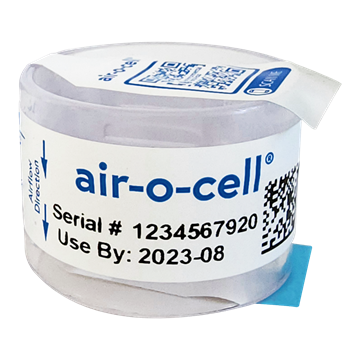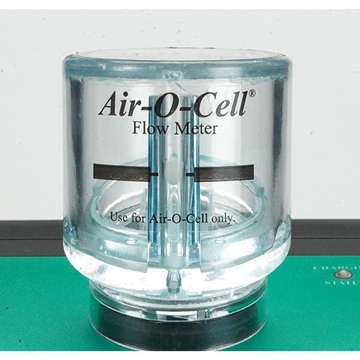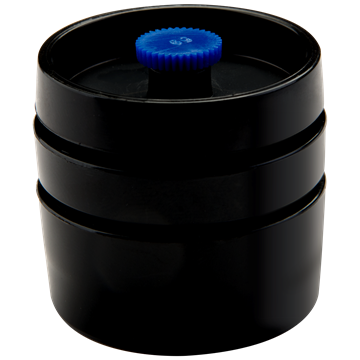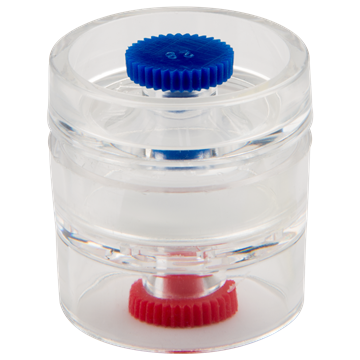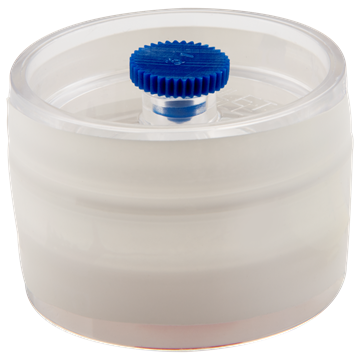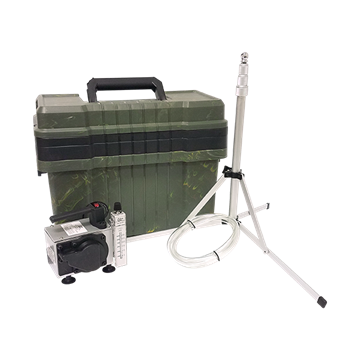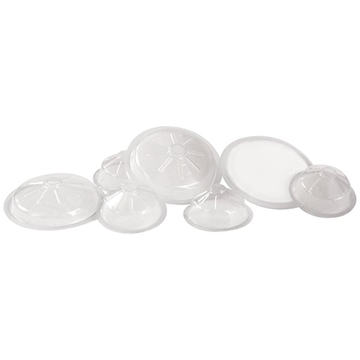- Register
- Log in
-
Shopping cart
(0)
You have no items in your shopping cart.
GILAIR-3 & GILAIR-5 Air Sampling System User Manual
Ref 360-0040-01 (M)
Download as PDF here

Buy:
GILAIR-3RC w/Clock Starter Kit, 120V
GILAIR-3RP Programmable Starter Kit, 120V
GILAIR-5RC w/Clock Starter Kit, 120V
GILAIR-5RP Programmable Starter Kit, 120V
SECTION ONE
INTRODUCTION
• COMPONENTS
• See Figures 1.1 (GilAir-3) and 1.2 (GilAir-5)
• All Models
(1) On/Off switch
(2) Flow Adjustment (requires slotted screwdriver)
(3) Rechargeable Battery Pack
(4) Internal/External Vent Control Use a flat-head screwdriver to adjust the internal/ external vent. The open circle position will vent the pump discharge external to the sampler case (recommended for moist or corrosive sampling environments). The closed circle will vent internally (recommended for dust laden environments).
(5) Battery Charge Indicator. Lights up when the pump is turned on and the battery pack is fully charged. The indicator will normally turn off after the pump runs for a short period of time.
(6) Flow Fault Indicator. Lights up if pump is unable to maintain flow rate within ± 5% of the set point. Occurs if pump is operated outside its specified performance ranges, or if battery pack has insufficient charge. After about 30 seconds of continuous operation under fault conditions, the pump will stop. For Clock and Program models, shutdown under fault conditions preserves the run time in the display.
• Clock and Program Models Only
(7) Liquid Crystal display (LCD) Note: All times are displayed in minutes.
(7.1) Battery icon. A flashing icon indicates battery voltage is below its nominal value.
(7.2) Hold icon. Appears on Clock and Program models when the MODE/HOLD is pushed while the pump is running.
(7.3) D and R.
D = Delay interval prior to starting first sampling interval (Program model only)
R = Run time interval (Clock & Program models)
D + R = Pause interval between Run Time Intervals (Program model only)
(7.4) Clock icon. Displayed when pump is executing a sampling run.
(7.5) 0. Indicates percent of time pump runs outside of ± 5% fault tolerance envelope during sampling run. Maximum indication is 9% regardless of actual performance.
(7.6) 4-Character Display. Display letters and messages listed below (Program model only unless otherwise noted):
C Cycles. The number of times the Run Time interval is performed.
PC Basic program which does the simple clock mode.
P1 User-defined program.
P2 User-defined program.
P3 User-defined program.
P4 User-defined program.
P5 User-defined program.
P6 User-defined program.
E Programming error.
LAST
Flashes alternately with the run time, R(7.3), and 0 (7.5) icons displayed (Clock & Program models).
Old
Flashes alternately with the run time, R (7.3), and 0 (7.5) icons displayed. Refers to run data prior to the LAST sampling run (Program model only).
SHUT/OFF (alternately)
Reminder message to turn the pump off. It indicates that 5 minutes have elapsed since:
1) a fault condition has terminated the sampling run, or
2) a programmed sampling run has reached completion.
CAL
Flashing: prepared to run the pump without gathering sampling data. Non-flashing: pump is running; enables calibration of pump’s air flow rate (Clock & Program models).
(8) MODE/HOLD button. Mode Change. Hold Operation.
(9) PROG button. Program Select. Accept Variable or Value shown on display.
(10)▲ and ▼ buttons. Increase or decrease a value or scroll through a menu list.
(11)Rotameter. Use as reference only. Actual flow should be set using a Gilibrator or another flow calibration device.

SECTION TWO
PUMP OPERATION
2.1 Setting/Verifying Flow Rate
• Equipment Set-Up
1) Use a GilAir-3 or GilAir-5 pump with a fully charged battery pack.
2) Attach tubing to the pump.
3) Connect the collection device to the tubing.
4) Connect the tubing from the collection media to a Gilibrator 2.
5) Setup and turn on the Gilibrator 2.

• Field Calibration/Flow Verification
Field calibration (flow rate verification) must be performed before sampling and when setting the flow rate.
• See Figure 2.2
For Basic models skip to Step 4. Pump should be off.
1) Use a small Phillips screwdriver to loosen the side anti-tamper plate screw
2) Rotate the side cover plate 180°.
3) Use a pointed instrument such as a ball-point pen or paper clip bent 90° to press the MODE/HOLD button twice. CAL should appear on the display. CAL allows you to run the pump without actually collecting run data. 3A = Clock model. 3B = Program model.
4) Use a small Phillips screwdriver to loosen the front anti-tamper plate screw.
5) Rotate the front cover plate 180°.
6) Move On/Off switch to the On position.
7) Make sure the Gilibrator 2 is on and working.
8) Set the pump flow rate by turning the flow adjust screw. (Clockwise for increased flow and counterclockwise for decreased flow. Use built-in rotameter only as a flow indicator. Use the Gilibrator 2 for actual calibration measurements.
9) When desired flow rate has been reached, turn off pump and Gilibrator 2. The pump is now ready for sampling.

2.2 Taking A Sample
Note for Basic Models
Start and stop times must be recorded to determine sample time.
1) Move the On/Off switch to the On position.
2) Place the pump, tubing and cassette on your person as shown in Figure 2.3.
3) When sampling is completed, move the On/Off switch to the Off position. Record sample data.
Note for Clock and Program Models
When the pump is shut off after a sample run, the accumulated run time minutes are displayed for 5 more minutes, along with “R” and the percentage of time the last sampling run varied more than ± 5% from the set flow rate. If you wish to return to a blank display immediately, perform a Display Self-Test (Clock Model, Section 3.2; Program Model, Section 3.6) 2 1 3 Battery Fault Battery Fault Flow Adj. On Off Flow Adj. On Off WARNING 5 4 3 1 2 Battery Fault Flow Possible static hazard. Do not rub with dry cloth. Substitution of components may impair intrinsic safety. Use only specified GilAir-3 battery packs. See Labeling for intrinsic safety approvals. Personal Air Sampler Gil ir3 A 4 3 2 1
Note
Total Air Volume (Liters) = Air Flow Rate (cc/min) x Sample Time (minutes) ÷ 1000 cc/Liter

SECTION THREE
DISPLAY FEATURES
3.1 Stopping The Sampling Run: Clock Model
Move the On/Off switch to Off to stop the sampling run.
The run time is displayed, “R”, and the percentage of time the sampling run varied more than ± 5% from set flow rate. Record the run data at this time.
The run data is displayed for 5 minutes, then shuts off. To immediately clear the display perform a display self-test (see Section 3.2).
3.2 Display Self-Test: Clock Model
Side Anti-Tamper Plate should be open and rotated. Pump should be off.
Using a pointed instrument push the MODE/HOLD button continuously for at least three seconds.
Display self-test begins, where all elements of the five digit positions are individually displayed, followed by all five digits simultaneously counting from 1 through 9, then back down to 1.
Each icon is individually displayed from right to left, followed by all the icons flashing twice before the display goes blank, terminating the test.
3.3 Retrieving “LAST” Run Data: Clock Model
Note: Side Anti-Tamper Plate should be open and rotated.
1) Make certain pump is off.
2) Using a pointed instrument push MODE/HOLD Button one time.
3) “LAST” is displayed.
4) The run time is displayed, “R”, and the percentage of time the last sampling run varied more than ± 5% from set flow rate. Record the LAST run data at this time.
The display continues alternating between these two screens for 5 minutes, then shuts off.
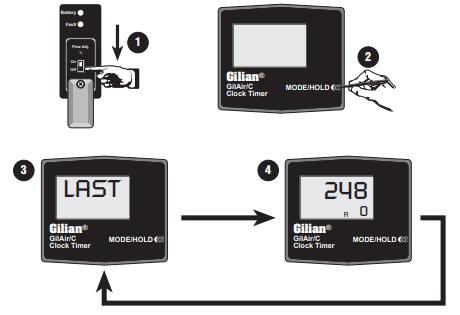
3.4 Pausing A Sampling Run: Clock Model
Note: Side Anti-Tamper Plate should be open and rotated.
1) Make certain pump is running.
2) The clock icon indicates the pump is taking a sample.
3) Using a pointed instrument push MODE/HOLD button for at least 1 second.
4) The flashing hand icon, along with the run time, “R”, and the percentage of time the last sampling run varied more than ± 5% from set flow rate.
5) To resume sampling, again push the MODE/HOLD button for at least 1 second.
6) The flashing hand icon is removed, pump resumes sampling, and the run time clock begins again
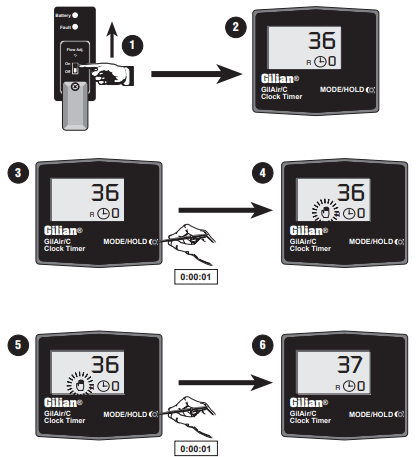
3.5 Stopping The Sampling Run: Program Model
Move the On/Off switch to Off to stop the sampling run.
Display shows the run time, “R”, and the percentage of time the sampling run varied more than ± 5% from set flow rate. Record the run data at this time.
Display continues to show the run data for 5 minutes, then shuts off. To immediately clear the display perform a display self-test (see Section 3.6).
3.6 Display Self-Test: Program Model
Side Anti-Tamper Plate should be open and rotated. Pump should be off.
Using a pointed instrument push the MODE/HOLD button continuously for at least three seconds.
Display self-test begins, where all elements of the five digit positions are individually displayed, followed by all five digits simultaneously counting from 1 through 9, then back down to 1.
Each display Icon is individually displayed from right to left, followed by all the icons flashing twice before the display goes blank, terminating the test.
3.7 Retrieving “LAST” Run Data: Program Model
Note: Side Anti-Tamper Plate should be open and rotated.
1) Make certain pump is off.
2) Using a pointed instrument push MODE/HOLD Button one time.
3) “LAST” is displayed.
4) Display then shows the program number as “Px,” where “x” can be the letter C or 1 through 6.
5) The run time is then displayed, “R”, and the percentage of time the last sampling run varied more than ± 5% from set flow rate. Record the LAST run data at this time.
The display continues alternating among these three screens for 5 minutes, then shuts off.

3.8 Pausing A Sampling Run: Program Model
Note: Side Anti-Tamper Plate should be open and rotated.
1) Make certain pump is running.
2) Display shows that pump is taking a sample.
3) Using a pointed instrument push MODE/HOLD button for at least 1 second.
4) The flashing hand icon is displayed, along with the run time, “R”, and the percentage of time the last sampling run varied more than ± 5% from set flow rate.
5) To resume sampling, again push the MODE/HOLD button for at least 1 second.
6) The display shows that the pump has resumed sampling.
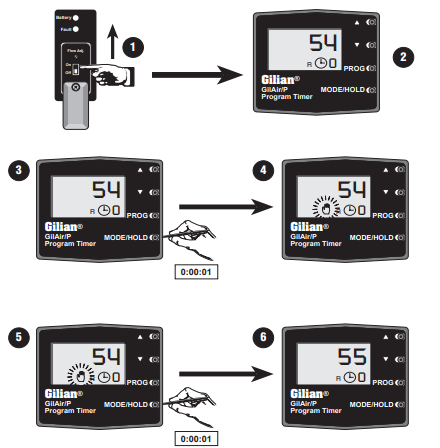
3.9 Programming The Pump
Side Anti-Tamper Plate should be open and rotated. Pump should be off.
• See Figure 3.1
1) Using a pointed instrument, press MODE/HOLD button. Display shows “LAST” [1A] followed by screen showing current program number [1B], followed by screen showing the run time, “R”, and the percentage of time the last sampling run varied more than ± 5% from set flow rate. The three screens repeat.
2) Press the ▲ or ▼ buttons while “LAST” is displayed [2A] to change the program number upward or downward [see 2B]. Continue to press the ▲ or ▼ buttons to further increase or decrease the program number (Px, where x can be “C” or a number from 1 to 6).
3) Press the PROG button to view the current Delay Time (represented by “D” icon in the display window [3A]). The clock icon is flashing. Press the ▲ or ▼ buttons [3B] to either increase or decrease the Delay Time [3C]. The Delay Time is the number of minutes after the pump is turned on before it actually starts sampling.
4) Press the PROG button again to view the current Run Time (represented by “R” icon in the display window [4A]). The clock icon is flashing. Press the ▲ or ▼ buttons [4B] to either increase or decrease the Run Time [4C]. The Run Time is the number of minutes the pump will sample before stopping and going into Run Delay mode.
5) Press the PROG button again to view the current Run Delay Time (represented by “D” & “R” icons in the display window [5A]). The clock icon is flashing. Press the ▲ or ▼ buttons [5B] to either increase or decrease the Run Delay Time [5C]. The Delayed Run Time is the number of minutes between successive Run Time intervals.
6) Press the PROG button again to view the current Cycle Count (represented by “C” icon in the display window [6A]). The clock icon is flashing. Press the ▲ or ▼ buttons [6B] to either increase or decrease the Cycle Count [6C]. The Cycle Count variable defines the number of times that the Run Time intervals are executed.
7) Press the PROG button again to accept the program changes and return to the flashing “Px” display [7A]. This completes the programming phase for this selected program number
NOTE
If the Run Time and Cycle Count variables are large enough to result in a total run time of more than 9,999 minutes, the unit will remain in the Cycle Count programming mode with a flashing “E” in the small digit area, until a value for Cycle Count is acceptable when the PROG button is pressed.
Once the pump is programmed it will default to the program number used for the last sampling run when the display is turned on [1].
To switch to another program number without making any changes, follow Steps 2A and 2B. Continue pressing the PROG button only in Steps 3 through 6 until the display shows the flashing program number [7A].

SECTION FOUR
MAINTENANCE
4.1 Battery Maintenance
The GilAir-3 and GilAir-5 air sampling pumps use rechargeable Nickel-Cadmium or Nickel-Metal-Hydride batteries that must be fully charged and properly maintained to achieve maximum pump run time. The battery pack may be charged separately or while installed on the pump.
WARNING
Do not clean, open case, charge or replace battery while in an explosive atmosphere.
Battery packs are charged through a built-in jack, on the side of the battery pack. Note: The charging plug is polarized to prevent improper insertion.
CAUTION
Do not short the battery terminals or the charging jack. Shorting will result in irreversible damage to the battery pack.
• Memory Effect
Nickel-Cadmium batteries will develop reduced capacity when they are not fully discharged and then fully recharged after sampling. Memory effect takes time to develop and can usually be eliminated by performing two complete discharge/recharge cycles on the pump.
• Leakage Current
Nickel-Cadmium and Nickel-Metal-Hydride batteries always have a small internal leakage current. If the battery pack has been removed from the charger for more than two days without use, it will require additional charging to restore it to full capacity. This process can be repeated two or three times without cause.
NOTE
Charger must be connected at AC mains supply Before being connected to battery or pump for charging.
• Chargers
NOTE
See Battery/Charger compatibility matrix in Appendix A: Parts List.
Single Station Charger
A constant-rate charger that automatically shuts down when charging is complete.
A dual rate charger that can be switched from constant-rate charge to trickle charge.
Universal Multi-Station Charger
A dual rate charger offering five-station timed constant-rate charging that automatically defaults to trickle charge.
BMS Multi-Station Charger
WARNING
DO NOT use the BMS-200 charger to charge Ni-MH battery version pumps. Use ONLY the BMS II-100CE model with Ni-MH battery models to prevent permanent damage to the batteries.
A five-station charger offering timed charging that defaults to a trickle charge in either a constant-rate charging mode or two diagnostic modes.
NOTE
The BMS Multi-Station Charger has a single and double discharge mode (Single Evaluation and Double Evaluation) designed to enhance the performance of NickelCadmium batteries. Excessive use of these discharge/ charge features will needlessly shorten battery life. We recommend use of the Double Evaluation mode for maintenance only (maximum once monthly) for use with Nickel-Cadmium batteries. These modes offer no advantage with Nickel-Metal-Hydride batteries.
4.2 Filter Maintenance
The inlet filter should be changed after six months of regular use or whenever the outer portion of the filter becomes discolored. The filter center retains its original color as a reference.
1) Unscrew and remove the four filter housing screws [1].
2) Remove the filter housing [2].
3) Remove the large filter o-ring [4].
4) Remove the filter [3]. Make certain the small center o-ring [5] is properly seated inside the pump.
5) Place the new filter inside the filter housing [2], followed by the filter o-ring [4].
6) Install the filter housing [2] in the pump and secure with the four housing screws [1].

APPENDIX A
PARTS LIST
Accessories
Part Number Description
800518 ........................ GilAir-3 / GilAir-5 Low flow Module, Constant Flow
800519 ........................ GilAir-3 / GilAir-5 Low flow Module, Multi-Flow
800149 ........................ Tube Holder Kit, Single Tube Holder Assembly (No Manifold), 6 x 70 mm
800259 ........................ Tube Holder Kit, Single Tube Holder Assembly (No Manifold), 7-10 x 110 mm
800148 ........................ Tube Holder Kit, Dual Manifold (Holders/Ends/Tubing), 6 x 70 mm
801407 ........................ Tube Holder Kit, Dual Manifold (Holders/Ends/Tubing), 10 x 110 mm
200484 ........................ Tubing, 36”, 1/4” ID
800159 ........................ Tubing, 36”, 1/8” ID (with 1/4” ID adapter)
200505 ........................ Tubing, 36”, 1/8” ID
Spare Parts
Part Number Description
800320-2 ..................... GilAir-3 / GilAir-5 Airboss and Restrictor Kit
380-0015-01 ................ GilAir-3 / GilAir-5 Tool Kit
800464 ........................ GilAir-3 Battery Pack [UL] NiCd
783-0008-03 ................ GilAir-3 Battery Pack [UL/ATEX] NiMH
800869 ........................ GilAir-5 Battery Pack [UL] NiCd
783-0009-02 ................ GilAir-5 Battery Pack [UL/ATEX] NiMH
298-0006-01 ................ GilAir-3 & GilAir-5 Single Unit 120 VAC Charger
401097-1 ..................... GilAir-3 Single Unit 230 VAC Charger [euro plug]
401225-1 ..................... GilAir-5 Single Unit 230 VAC Charger [euro plug]
201050 ........................ Filter (package of 1)
201050-100 ................. Filter (package of 100)
360-0040-01 ................ Gilair-3 / GilAir-5 Operation Manual
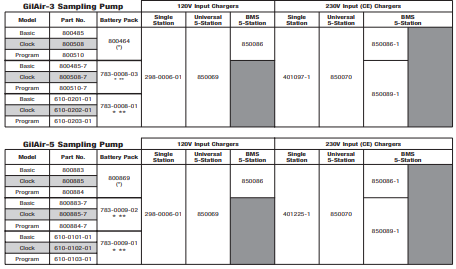
APPENDIX B
SPECIFICATIONS
General Specifications
Controls ......................................................... Power Switch, Flow Control (all models), plus: MODE/HOLD button (Clock Model) MODE/HOLD, PROG, ▲, & ▼ buttons (Program Model)
Indicators ...................................................... Display (LCD), Battery (Green) LED, Fault (Red) LED
Display Ranges ............................................. 0–9999 (Timing), 0–9 (Error Percentage)
Display Messages.......................................... LAST, CAL, SHUT/OFF (Clock & Program Models) E, PC, P1–P6, OLD (Program Model)
Dimensions (GilAir-3) .................................. 3.6” (H) x 3.9” (W) x 2.0” (D) 90 mm (H) x 100 mm (W) x 51 mm (D)
Dimensions (GilAir-5) .................................. 4.1” (H) x 3.9” (W) x 2.0” (D) 103 mm (H) x 100 mm (W) x 51 mm (D)
Weight (GilAir-3) .......................................... 21 oz. (595 g)
Weight (GilAir-5) .......................................... 22.5 oz. (638 g)
Power Supply
Battery Pack .................................................. GilAir-3: 4.8 volt, 1.8 amp hour GilAir-5: 6 volt, 1.8 amp hour
Battery Type.................................................. Rechargeable Nickel-Cadmium or Nickel-Metal-Hydride
Battery Charge Time..................................... 14–18 hours
Expected Battery Life †................................. 300–500 charge/discharge cycles
Estimated Battery Life † ................................ 2.5 years (< 20 hours weekly use) 1.5–2.5 years (20–39 hours weekly use) 1–1.5 years (40–60 hours weekly use)
† Inactivity for extended periods may shorten nickel-cadmium battery life. Battery life estimates are based on proper battery maintenance.
Operating Specifications
Constant High Flow Range .......................... GilAir-3: 850–3000 cc/min GilAir-5: 850–5000 cc/min
Flow Control ................................................. External Flow Adjust (± 5% of set point)
Constant Flow (Low Flow)........................... 5–500 cc/min to 25” H20 (640 mm Hg)
Multi-Flow (Low Flow)................................. 1–750 cc/min, to 18”+3” H20 (460+80 mm Hg)
Operating Temperature Range .................... 32° to 104°F (0° to 40°C)
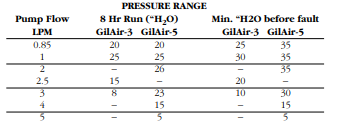
APPENDIX C
TROUBLESHOOTING GUIDE
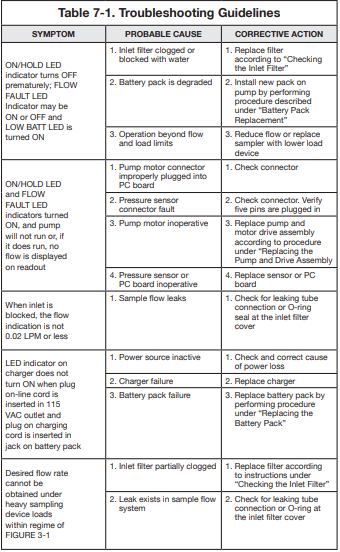
APPENDIX D
CONSTANT LOW FLOW MODULE
D.1 Overview
The Constant Low Flow Module is suitable for sampling between 5 and 500 cc/min , and maintains a constant sampling flow despite load changes up to 25” H2O.
D.2 Installing The Constant Low Flow Module
NOTE
Install the Low Flow Module in a clean environment with the pump turned off.
• See Figure D.1
1) Remove the airboss cover on top of the pump [1]. Make sure the o-ring seals [5] are properly seated.
2) Place the Low Flow Module [2] onto the airboss opening. Make certain the mating boss clears the case opening prior to securing.
3) Secure the Low Flow Module with the mounting screws [3]. Do not overtighten.
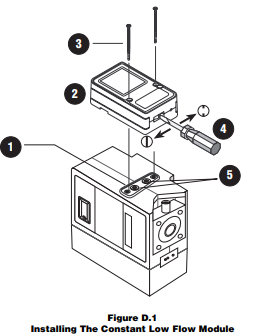
APPENDIX D
CONSTANT LOW FLOW MODULE
D.3 Constant Low Flow Calibration Set-Up
• See Figure D.2
The front anti-tamper cover plate should be open and rotated. The pump should be off.
Set up the calibration equipment as shown. Make certain that the sampling media [A] is properly installed as shown.
1) Use a flat screwdriver to move the notch in the module valve [1] to the Off position.
2) Turn on the pump [2].
3) Adjust the flow to between 1.0 and 1.5 LPM [4] using the flow adjustment [3].
4) Use a flat screwdriver to move the notch in the module valve [5] to the On position.
5) Using a fine screwdriver [6], adjust the flow rate at the module.
NOTE
The built-in rotameter does not indicate the flow rate through the sampling media.
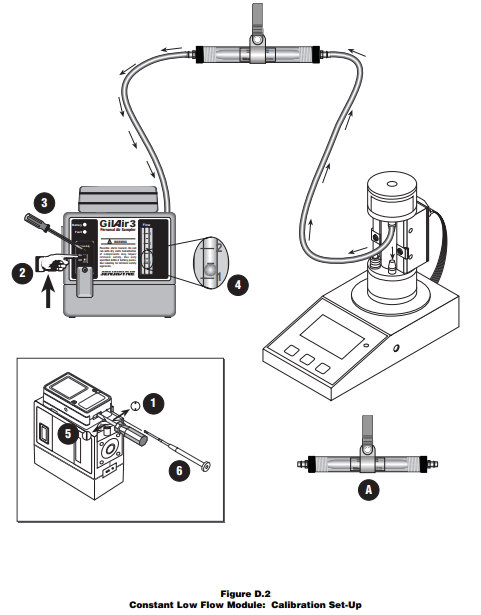
D.4 Bag Sampling Installation
The module is provided with an internal Luer taper for bag sampling. The unique feature of this system is that it will automatically shut the flow off when the bag has been filled. The maximum pressure within the bag is approximately 8” of water.
• See Figure D.3
1) Insert the Luer taper [1].
2) Attach the tubing [2] to the taper.
3) Connect the tubing to the sampling bag [3].
4) Before sampling set the flow with a fine screwdriver [4] using a Gilibrator.

APPENDIX E
MULTI-FLOW MODULE
E.1 Overview
The Multi-Flow Module is suitable for multiple tube sampling between 1 and 750 cc/min and can be used in conjunction with the Gilian Universal Tube Holder System to perform multiple tube sampling.
E.2 Installing The Multi-Flow Module
NOTE
Install the Multi-Flow Module in a clean environment with the pump turned off.
• See Figure E.1
1) Remove the airboss cover on top of the pump [1]. Make sure the o-ring seals [5] are properly seated.
2) Place the Multi-Flow Module [2] onto the airboss opening. Make certain the mating boss clears the case opening prior to securing.
3) Secure the Multi-Flow Module with the mounting screws [3]. Do not overtighten.

E.3 Multi-Flow Calibration Set-Up
• See Figure E.2
The front anti-tamper cover plate should be open and rotated. The pump should be off.
Set up the calibration equipment as shown. Make certain that the sampling media [A], [B], [C] or [D] is properly installed as shown.
1) Use a flat screwdriver to move the notch in the module valve [1] to the Off position.
2) Turn on the pump [2].
3) Adjust the flow to between 1.0 and 1.5 LPM [4] using the flow adjustment [3].
4) Use a flat screwdriver to move the notch in the module valve [5] to the On position.
5) Using a fine screwdriver [6], adjust the flow rate on the variable manifold for each manifold used.
NOTE
The built-in rotameter does not indicate the flow rate through the sampliing media.

E.4 Bag Sampling Installation
The module is provided with an internal Luer taper for bag sampling.
• See Figure E.3
1) Insert the Luer taper [1].
2) Attach the tubing [2] to the taper.
3) Attach the adapter [3] to the variable manifold [4].
4) Connect the tubing [2] to the adapter [3].
5) Connect a short piece of tubing [5] to the variable manifold [4].
6) Connect the tubing [5] to the sampling bag [6].
7) Remove the variable manifold cap [7].
8) Before sampling set the flow with a fine screwdriver [8] on the variable manifold [4] using a Gilibrator.

APPENDIX F
SERVICE
Domestic Service
Sensidyne, LP 1000 112th Circle N, Suite 100 St. Petersburg, Florida 33716 USA
800-451-9444
727-530-3602
727-539-0550 [Main fax]
727-538-0671 [Service fax]
e-mail: [email protected]
web: www.Sensidyne.com
European Service
Goffin Meyvis Analytical and Medical Systems B.V.
Deliveries:
Ecustraat II 4879 NP Etten Leur the Netherlands
Mail: P. O. Box 251 4870 AG Letten Leur the Netherlands
+31 (0)76 5086000
+31 (0)76 5086086 [fax]
e-mail: [email protected]
web: www.goffinmeyvis.com
PROPRIETARY NOTICE
This manual was prepared exclusively for the owner of the Sensidyne GilAir Air Sampling System. The material within this manual is proprietary information and is to be used only to understand, operate, and service the instrument. By receiving this document, the recipient agrees that neither this document nor the information disclosed within nor any part thereof shall be reproduced or transferred, physically, electronically or in any other form, or used or disclosed to others for manufacturing or for any other purpose except as specifically authorized in writing by Sensidyne, LP.
COPYRIGHT NOTICE
© 2005, 2008, 2012 Sensidyne, LP All Rights Reserved. No part of this document may be reproduced, transmitted, transcribed, stored in a retrieval system, or translated into any language in any form by any means without the prior written permission of Sensidyne, LP.
TRADEMARK NOTICE
Sensidyne, the Sensidyne logo, Gilian, and the Gilian logo are registered trademarks. These trademarks are protected through use and registration in the United States. The trademarks and servicemarks used in this document are the property of their respective companies and are used only for informational and explanatory purposes.
DISCLAIMER
THE SELLER ASSUMES NO RESPONSIBILITY WHATSOEVER, TO ANY PARTY WHOSOEVER, FOR ANY PROPERTY DAMAGE, PERSONAL INJURY, OR DEATH RECEIVED BY OR RESULTING FROM, IN WHOLE, OR IN PART, THE IMPROPER USE, INSTALLATION, OR STORAGE OF THIS PRODUCT BY THE USER, PERSON, FIRM, ENTITY, CORPORATION OR PARTY NOT ADHERING TO THE INSTRUCTIONS AND WARNINGS IN THIS MANUAL, OR OTHERWISE PROVIDED BY THE SELLER OR FROM NOT ADHERING TO ALL FEDERAL, STATE, AND LOCAL ENVIRONMENTAL AND OCCUPATIONAL HEALTH AND SAFETY LAWS AND REGULATIONS. THE SELLER SHALL NOT BE LIABLE FOR DIRECT, INDIRECT, CONSEQUENTIAL, INCIDENTAL OR OTHER DAMAGES RESULTING FROM THE SALE AND USE OF ANY GOODS AND SELLERS’ LIABILITY HEREUNDER SHALL BE LIMITED TO REPAIR OR REPLACEMENT OF ANY GOODS FOUND DEFECTIVE. THIS WARRANTY IS IN LIEU OF ALL OTHER WARRANTIES, EXPRESSED OR IMPLIED, INCLUDING BUT NOT LIMITED TO THE IMPLIED WARRANTIES OF MERCHANTABILITY AND FITNESS FOR USE OR FOR A PARTICULAR PURPOSE WHICH ARE EXPRESSLY DISCLAIMED.
WARNINGS
READ AND UNDERSTAND ALL WARNINGS AND INSTRUCTIONS BEFORE USE Failure to read, understand, and comply with ALL accompanying literature, product labels, and warnings could result in property damage, severe personal injury, or death. Read and understand ALL applicable environmental health and safety laws and regulations. Ensure complete compliance with ALL applicable laws and regulations before and during use of this product. DO NOT remove, cover, or alter any label or tag on this product, its accessories, or related products. UNDER NO CIRCUMSTANCES should this product be used except by qualified, trained, technically competent personnel. DO NOT operate this product should it malfunction, require repair, or have a cracked or broken case. DO NOT repair or modify, except as specified in Operation Manual. Service to be performed by Sensidyne Authorized Service Departments only. Use ONLY specified Sensidyne parts when performing maintenance procedures described in this manual. Intrinsic safety certifications become void by substitution of components, unauthorized repair or alteration. This product is intended for both indoor and outdoor use when protected from splashed or wind blown liquids. The unit is not waterproof so NEVER submerge the unit in water. Pump failure or faulting may result. Possible static hazard. Do not rub with dry cloth. DO NOT clean, open case, charge or replace batteries in an explosive atmosphere. This product uses rechargeable Nickel-Cadmium or Nickel-Metal-Hydride batteries. ALWAYS fully charge before use. Use only battery pack and chargers specified in Operation Manual. DO NOT insert any foreign objects into contact slot. Shorting contacts will blow protective fuse. DO NOT use BMS-200 charger to charge Ni-MH battery version pumps. Some models of this product use Nickel-Cadmium batteries which may not be disposed to normal landfill due to the Cadmium content. Dispose of Nickel-Cadmium batteries only according to local and federal regulations. Maximum Allowable Charging Voltages (Um): GilAir-3: 6 Vrms (≥ 250 mA) 21 Vrms (< 250 mA) GilAir-5: 7 Vrms (≥ 250 mA) 21 Vrms (< 250 mA) If the equipment is likely to come into contact with aggressive substances, then it is the responsibility of the user to take suitable precautions that prevent it from being adversely affected, thus ensuring that the type of protection is not compromised. Examples of aggressive substances are acidic liquids or gases that may attack metals, or solvents that may affect polymeric materials. Examples of suitable precautions are regular checks as part of routine inspections or establishing from material data sheets that it is resistant to specific chemicals. DO NOT operate with a dirty or blocked inlet filter or kinked tubing. Pump failure or faulting may result. Caution: Both charger and battery become warm during charging. If further translation is required, please contact Schauenburg Electronic Technologies GmbH, the Sensidyne EU Authorized Representative.
CERTIFICATIONS

FRONT NAMEPLATES
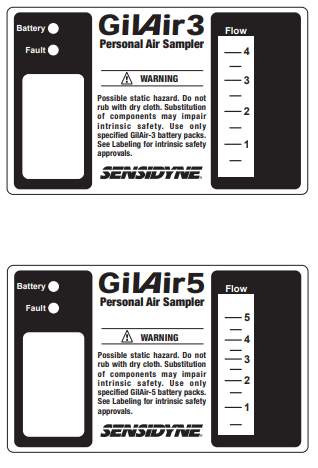
Manufactured by: Sensidyne, LP 1000 112th Circle N, Suite 100 St. Petersburg, Florida 33716 USA 800-451-9444 • 727-530-3602 • 727-539-0550 [fax] www.Sensidyne.com • [email protected] Authorized EU Representative Schauenburg, Electronic Technologies GmbH Weseler Str. 35 • 45478 Mulheim-Ruhr Germany Tel. +49 (0) 208 9 99 10 • Fax. +49 (0) 208 5 41 10 www.schauenburg.com • [email protected]

























